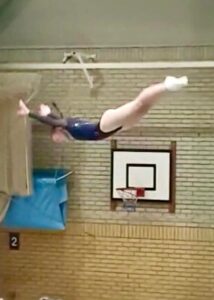Crash Dive Ballouts
Another great article from Cathy Page’s Trampoline Extra:

Why are so many Crash Dive, barani ball outs still done so badly and take people so long to learn them?
- Firstly pupils are rushed through the proficiency scheme, if it is used at all, and Hands & Knees forward turnover is neglected.
- Secondly the back landing from forward rotation isn’t taught accurately.
- Thirdly Crash Dive isn’t taught to lift and because the back landing hasn’t been introduced early enough the landing is worrying to the pupil.
So where do you begin?
Learn an accurate back landing from forward rotation. Study of film, video and mechanics over the years has shown that the best landing position on the back when rotating forwards is to land with the legs exactly vertical, the shoulders firmly in the bed, the head on the bed, and the arms parallel with the bed alongside the head. Like a large L shape. The arms and trunk should be at right angles to the legs. The head position is particularly important so that it cannot flick back and give multiple small whiplashes to the neck, in other words a safety feature as well as technically better. A rounded back with head and shoulders off the bed is not correct.
Small Increments
This is best learnt from a forward roll from hands and knees and then progress to Hands and Knees forward turnover to back (Award 7). It is low and easy for pupils to get an accurate landing before introducing height. It is reinforced in Award 8 at the end of the routine.
Gradually a bit of height is developed and vision of the bed as they duck under.
In Award 9 the Hands and Knees take off is dropped and having got used to landing on the back they are ready to go straight on to ¾ forward turnover to back. Again the back landing is emphasized. At this point the pupil should be seeing the duck under for the back landing accurately. As they improve they could work to get ¾ turnover, ½ twist to feet, tuck jump ,repeat x 3 as a drill. The ½ twist will help them to kick up of their backs ready for bounce rolls and ball outs. The legs should be directed straight up from the vertical position to get rotation ½ twist to feet high.
Gradually the ¾ turnover is straightened out with the emphasis being – take the head and chest up, on take off, to the height it is when doing preliminary bounces. At the same time push the feet back and up.
The vision of the duck under is retained but at the start of the move look forward to the end mat. Look at the mat on the way up and look at the bed on the way down. The drill now becomes Crash Dive, ½ twist to feet, tuck jump x 3.
Initially the Crash Dive will duck under from roughly a horizontal body position, but gradually the duck under shouldn’t occur till the body is vertical upside-down, so more rotation is needed.
Once the back landing and the lifted Crash Dive are consistent, ball outs are easy.
© Cathy Page

